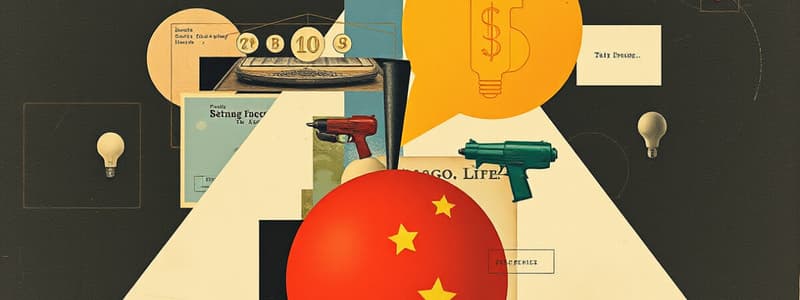Podcast
Questions and Answers
What is the primary goal of innovation as defined in Innovation Management?
What is the primary goal of innovation as defined in Innovation Management?
To transform existing ideas into new products or services that create wealth or improve societal well-being.
List the three key steps involved in the innovation process.
List the three key steps involved in the innovation process.
Idea, Create, Validate.
Describe the Innovation Cycle in brief.
Describe the Innovation Cycle in brief.
The Innovation Cycle consists of Think, Make, Try, and Refine.
What is Disruptive Innovation?
What is Disruptive Innovation?
How does innovation serve as a strategy for businesses?
How does innovation serve as a strategy for businesses?
What role does technology play in the innovation process?
What role does technology play in the innovation process?
Why is validating an idea a critical step in the innovation process?
Why is validating an idea a critical step in the innovation process?
What is the significance of refinement in the Innovation Cycle?
What is the significance of refinement in the Innovation Cycle?
What is sustaining innovation and how does it benefit a company?
What is sustaining innovation and how does it benefit a company?
Describe an example of sustaining innovation and its impact on a market.
Describe an example of sustaining innovation and its impact on a market.
What are Peter Drucker’s Seven Sources of Innovation?
What are Peter Drucker’s Seven Sources of Innovation?
List the steps involved in the New Product Development (NPD) process.
List the steps involved in the New Product Development (NPD) process.
What characterizes the introduction stage of the Product Life Cycle?
What characterizes the introduction stage of the Product Life Cycle?
How does sustaining innovation influence consumer choices?
How does sustaining innovation influence consumer choices?
What role does idea generation play in the New Product Development process?
What role does idea generation play in the New Product Development process?
Why is it important for companies to understand the Product Life Cycle?
Why is it important for companies to understand the Product Life Cycle?
How has the emergence of excellent cameras on cell phones disrupted the digital camera industry?
How has the emergence of excellent cameras on cell phones disrupted the digital camera industry?
Define breakthrough innovation and provide an example.
Define breakthrough innovation and provide an example.
What is radical innovation and how does it benefit consumers?
What is radical innovation and how does it benefit consumers?
Explain incremental innovation and its significance in product development.
Explain incremental innovation and its significance in product development.
How do breakthrough and radical innovations differ in terms of market impact?
How do breakthrough and radical innovations differ in terms of market impact?
Discuss the role of consumer desire in incremental innovation.
Discuss the role of consumer desire in incremental innovation.
In what way can new technologies open up new markets according to radical innovation?
In what way can new technologies open up new markets according to radical innovation?
Give an example of how old technology can be harnessed in new ways.
Give an example of how old technology can be harnessed in new ways.
Flashcards are hidden until you start studying
Study Notes
Innovation Management Overview
- Innovation involves transforming existing concepts into new products or services that create wealth or enhance societal well-being.
- It is a vital strategy for competitive advantage, requiring the translation of ideas into tangible solutions addressing consumer needs.
- The innovation process can be broken down into three essential steps: Idea, Create, and Validate.
- The Innovation Cycle includes: Think, Make, Try, and Refine.
Types of Innovation
-
Disruptive Innovation:
- Creates new markets and customer segments, often rendering traditional approaches obsolete.
- Utilizes modern technology in innovative ways to develop new business models.
- Example: Advanced smartphone cameras disrupting the digital camera industry.
-
Breakthrough Innovation:
- Introduces solutions that radically shift paradigms globally, often employing new technology.
- Consumers may not recognize their need for these innovations until experiencing them.
-
Radical Innovation:
- Completely reshapes industry norms to provide new consumer benefits using cutting-edge technology.
- Example: Apple AirPods revolutionizing wireless technology in personal audio devices.
-
Incremental Innovation:
- Focuses on gradual improvements over time through minor adjustments and feature enhancements.
- Primarily driven by consumer desires for product refinement.
- Example: Newer iPhone models featuring better cameras and processors.
-
Sustaining Innovation:
- Involves enhancing existing products based on predicted consumer needs to retain loyalty without altering company goals.
- Expands product lines to provide a broader array of consumer choices.
- Example: Smaller, affordable copiers designed for personal use by reconfiguring existing large models.
Sources of Innovation
- Peter Drucker’s Seven Sources:
- Unexpected occurrences
- Incongruities in processes or perception
- Specific process needs
- Structure of industries or markets
- Demographic shifts
- Cultural mood or meaning
- New knowledge advancements
New Product Development (NPD) Process
- Encompasses the full cycle of bringing a new product to market, recognizing market opportunities and product availability.
- Key stages include:
- New product strategy formulation
- Idea generation
- Screening for feasibility
- Concept testing
- Business analysis for market viability
- Actual product development
- Market testing before full launch
- Final product launch
Product Life Cycle Stages
- Introduction Stage:
- Characterized by low sales, high per-customer costs, and potential financial losses.
- Few competitors present, targeting early adopters or innovative customers.
Studying That Suits You
Use AI to generate personalized quizzes and flashcards to suit your learning preferences.




